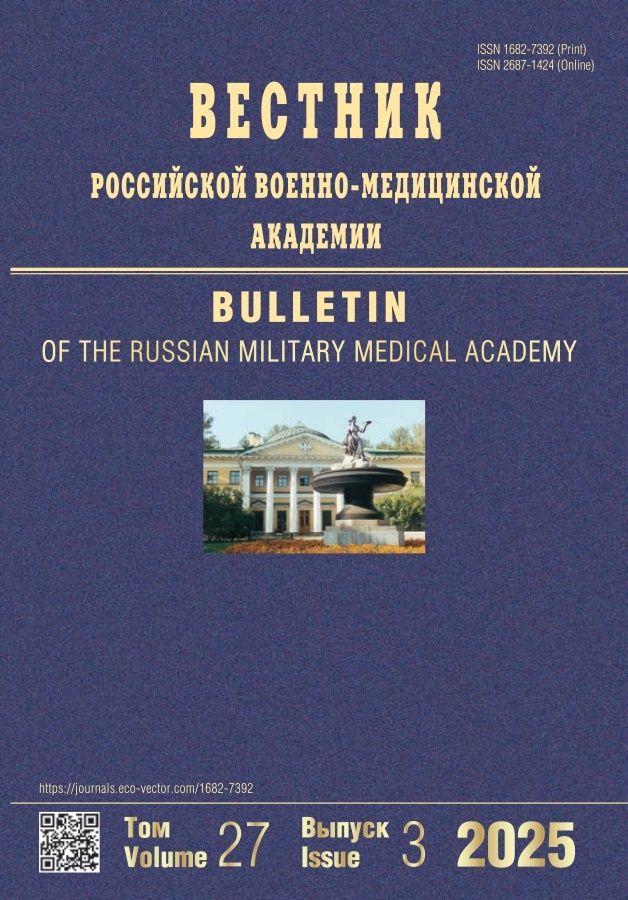Экспериментальная оценка эффективности нового отечественного местного гемостатического средства на основе хитозана
- Авторы: Денисов АВ1, Носов АМ1, Телицкий СЮ1, Демченко КН1, Юдин АБ2, Шперлинг ИА2, Миляев АВ2, Гребенюк АН3
-
Учреждения:
- Военно-медицинская академия им. С.М. Кирова
- Государственный научно-исследовательский испытательный институт военной медицины МО РФ
- Военно-медицинская академия им. С.М. Кирова Общество с ограниченной ответственностью «Специальная и медицинская техника»
- Выпуск: Том 20, № 3 (2018)
- Страницы: 159-163
- Раздел: Статьи
- URL: https://journals.rcsi.science/1682-7392/article/view/12325
- DOI: https://doi.org/10.17816/brmma12325
- ID: 12325
Цитировать
Полный текст
Аннотация
Полный текст
Открыть статью на сайте журналаОб авторах
А В Денисов
Военно-медицинская академия им. С.М. Кирова
Email: vmeda-nio@mil.ru
А М Носов
Военно-медицинская академия им. С.М. Кирова
Email: vmeda-nio@mil.ru
С Ю Телицкий
Военно-медицинская академия им. С.М. Кирова
Email: vmeda-nio@mil.ru
К Н Демченко
Военно-медицинская академия им. С.М. Кирова
Email: vmeda-nio@mil.ru
А Б Юдин
Государственный научно-исследовательский испытательный институт военной медицины МО РФ
И А Шперлинг
Государственный научно-исследовательский испытательный институт военной медицины МО РФ
А В Миляев
Государственный научно-исследовательский испытательный институт военной медицины МО РФ
А Н Гребенюк
Военно-медицинская академия им. С.М. Кирова Общество с ограниченной ответственностью «Специальная и медицинская техника»
Email: vmeda-nio@mil.ru
Список литературы
- Директива 2010/63/EU Европейского парламента и совета европейского союза по охране животных, используемых в научных целях. - СПб.: Rus-LASA «НП объединение специ- алистов по работе с лабораторными животными», рабочая группа по переводам и изданию тематической литературы, 2012. - 48 с.
- Крупин, А.В. Оценка развития спаечного процесса в сво- бодной брюшной полости при введении лабораторных образцов кровоостанавливающей гелиевой композиции на основе хитозана / А.В. Крупин [и др.] // Сб. тез. науч.-практ. конф. с международным участием «Скорая медицинская помощь - 2018». - 2018. - С. 83.
- Самохвалов, И.М. Местные гемостатические средства: новая эра в оказании догоспитальной помощи / И.М. Самохвалов [и др.] // Политравма. - 2013. - № 1. - С. 80-86.
- Самохвалов, И.М. Применение местного гемостатического средства «Celox» в экспериментальной модели массивного смешанного наружного кровотечения / И.М. Самохвалов [и др.] // Вестн. Росс. воен.-мед. акад. - 2013. - № 4 (44). - С. 187-191.
- Самохвалов, И.М. Сравнительная оценка эффективности и безопасности местных гемостатических средств в экс- перименте / И.М. Самохвалов [и др.] // Воен.-мед. жур. - 2017. - № 2. - С. 18-24.
- Самохвалов, И.М. Усовершенствование экспериментальной модели для изучения эффективности местных гемоста- тических средств / И.М. Самохвалов [и др.] // Воен.-мед. жур. - 2015. - Т. 336, № 3. - С. 19-25.
- Чепур, С.В. О выборе модели наружного кровотечения для доклинической оценки эффективности местных гемоста- тических средств (обзор литературы) / С.В. Чепур [и др.] // Воен.-мед. журн. - 2016. - Т. 337, № 7. - С. 25-33.
- Arnaud, F. Comparison of 10 hemostatic dressings in a groin transaction model in swine / F. Arnaud [et al.] // J. trauma. - 2009. - Vol. 67, № 4. - P. 848-855.
- Bellamy, R.F. The causes of death in conventional land warfare: implications for combat casualty care research / R.F. Bellamy // Mil. med. - 1984. - Vol. 149, № 2. - P. 55-62.
- Champion, H.R. A profile of combat injury / H.R. Champion [et al.] // J. trauma. - 2003. - Vol. 54, Suppl. 5. - S. 13-19.
- Gordy, S.D. Military applications of novel hemostatic devices / S.D. Gordy, P. Rhee, M.A. Schreiber // Expert. rev. med. devices. - 2011. - Vol. 8, № 1. - P. 41-47.
- Kheirabadi, B.S. Safety evaluation of new hemostatic dressing in a model of extremity arterial hemorrhage in swine // J. trauma injury, infection and critical care. - 2009. - Vol. 67, № 3. - P. 450-459.
- Pozza M. Celox (chitosan) for haemostasis in massive traumatic bleeding: experience in Afghanistan / M. Pozza, R.W. Millner // Eur. j. emerg. med. - 2011. - Vol. 18, № 1. - P. 31-33.
- Sohn, V.Y. Efficacy of three topical hemostatic agents applied by medics in a lethal groin injury model / V.Y. Sohn [et al.] // J. surg. res. - 2009. - Vol. 154, № 2. - P. 258-261.
Дополнительные файлы







